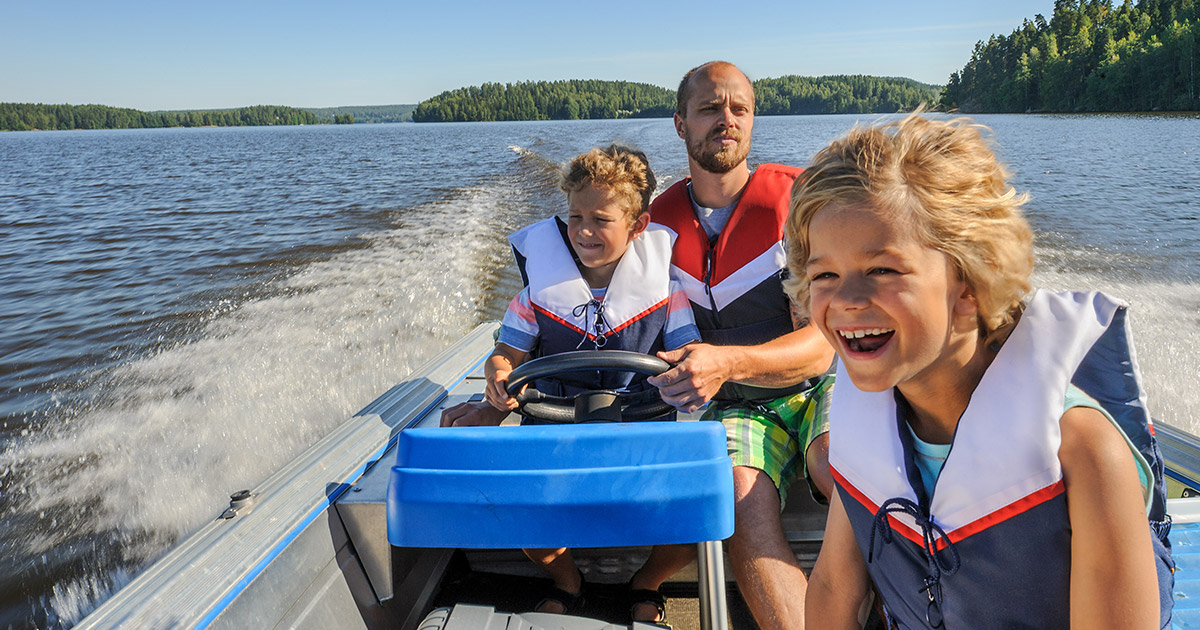What could be more idyllic than a lazy summer afternoon on the water — the wind in your hair, the warm rays on your face and the cool spray on your skin? Top it off with a little fishing, swimming or even water skiing, and it makes for great times with family and friends.
Yet, boating safety sometimes takes a backseat on summer outings, even when it shouldn't. According to the Coast Guard, in2019, there were over 4,000 boating accidents that resulted in over 600 deaths and 2,500 total injuries. Not to mention an estimated total of $55 million in property damage.
Most of these accidents are preventable if you take just a few simple precautions. To keep your pleasure cruise from taking a wrong turn this summer, check out these seven boating rules every boater should know.
1. Don’t drink and boat.
Many boaters would never consider drinking alcohol while driving a car but are more casual about popping open a beer while behind the wheel of a boat. However, drinking and boating can be just as dangerous as drinking and driving, can result in serious legal consequences and is responsible for about one-third of all recreational boating fatalities. Here are some important facts about drinking and boating to keep in mind:
- Operating a boat under the influence of alcohol (BUI) is illegal in all 50 states — and can also be a federal crime. In most states the legal limit for operating a boat is .08% blood alcohol level, the same as the limit for driving under the influence (DUI). In many cases, you’re considered legally drunk even if you only feel "buzzed." Reaching .08 %alcohol level would take about two drinks for a 120-pound woman or about five drinks for a 240-pound man. However, you could reach that level with fewer drinks if you’ve taken certain medications, haven’t eaten much today, are dehydrated or have a metabolism that doesn’t process alcohol efficiently. Depending on your state, penalties for boating under the influence can include large fines; jail time; loss of operating privileges for your boat, car or both; financial restitution for damages or injuries; felony conviction; and completion of an alcohol program or boating safety course.
- Alcohol can be even more hazardous on water than on land. The waves, vibration, engine noise, sun, wind, spray and other stressors of the marine environment can all accelerate the effects of alcohol and the drinker’s level of impairment. The same amount of alcohol can therefore impact a boat operator’s coordination, judgment and reaction time even faster than if he or she was driving a car. Some of the physical effects of drinking and boating include:
- Deterioration of cognitive abilities and judgment.
- Impairment of balance, coordination, vision and reaction time.
- Inner ear disturbances, making it difficult for someone who falls into the water to distinguish up from down.
- A physical sensation of warmth, preventing someone in cold water from getting out before hypothermia occurs.
- Because of these factors, boat operators with blood alcohol concentration above .10% are estimated to be more than 10 times more likely to die in boating accidents than if they had 0% blood alcohol concentration. Their passengers also have a greatly increased risk for injury and death — especially if they are drinking alcohol as well.
2. Always wear a life jacket.
The U.S. Coast Guard estimates that life jackets could have saved the lives of more than 80% of boating fatality victims — hundreds of people each year. Even though some states only require life jackets to be “accessible” instead of worn, with a sudden surprise impact of a boating accident, you may not have time to reach for a nearby life jacket. And modern life jackets are often thin, flexible and compact, so there’s really no excuse not to wear a life jacket every time you’re on a boat.
A few boating rules about life jackets to keep in mind:
- The U.S. Coast Guard requires boats to have a USCG-approved life jacket that is accessible, in good serviceable condition and of an appropriate size for each person on board. Boats 16 feet and longer are also required to have a Type IV throwable device on board.
- All states require children to wear life jackets. Adult-sized life jackets don’t work for children.Children need life jackets that are appropriate for their weight range, fit snugly and don’t allow their chin or ears to slip through. Make sure your child’s life jacket is USCG-approved and designed for their weight range. To check the fit, pick the child up by the shoulders of the life jacket. If it fits, his or her chin and ears will not slip through. Test your child’s life jacket in the water soon after purchase. Float testing can help you check the fit and buoyancy of the life jacket and also give you an opportunity to talk about boating safety and teach them to relax in the water when wearing their life jacket.
- Many states require wearing life jackets for certain activities, such as water skiing and other towed activities.
- Life jackets should be tested at least once each year. Life jackets that are worn out or have lost their buoyancy should be discarded.
3. Get ahead of the game.
Before you boat, take a few essential precautions to keep your outings safe and legal:
- Understand and follow the boating laws in your state. Most states require some type of boating safety certification and some require a boating license. Many states also have specific certification or licensing requirements for children under a certain age. Even if your state doesn’t require you to take a boating safety course, consider taking one. In many cases, you can find a free course in your state or area.
- Have the U.S. Coast Guard Auxiliary perform a free Vessel Safety Check (VSC) on your boat. The Coast Guard provides this service free of charge and risk free for recreational heicles. In order to request a VSC, fill out this form.
- Have a float plan. Document where you’re going, who is going with you and when you plan to return. Email the document to a friend or family member not in attendance who can be responsible for starting the search and rescue process if you don’t return when expected.
- Perform a pre-boarding boat safety check that includes:
- Checking that you have a full tank of gas, correct engine oil and transmission fluid levels, a fully-charged battery, full fluid levels, electronic gear in good condition and that all other components of your boat working properly and in good condition.
- After you refuel, opening your hatches and run the blower to sniff for fumes. If you smell fumes, don’t start the engine.
- Making sure you have your operator’s certificate or license and any registration or documentation for the boat onboard and current.
- In addition to life jackets, having other boat safety equipment onboard including a fire extinguisher, operable boat lights, extra batteries for the lights and a floating pouch that includes a cell phone, maps, flares and a first aid kit.
4. Watch for inclement weather.
Never leave the dock without first checking the local weather, as well as your destination forecast, if applicable. Beware that weather can change rapidly, even if it’s nice out when you set sail. Always bring a radio and continue to keep an eye out for inclement weather once you’re on the water. If you notice sudden wind shifts, dark skies, lightning or choppy water, get off the water as soon as possible.
5. Beware of your boat's propellers.
Boat propellers can inflict major injury on anyone in the water. To avoid propeller injuries:
- Before you start your engine, make sure all of your passengers are accounted for in the boat. Additionally, walk around the boat to make sure no one is in the water near the boat. People in the water may not always be visible from the boat’s helm.
- Watch children carefully while onboard. Don’t allow them to sit in an area of the boat from which they could fall near the propellers. If a child or adult falls overboard, stop the boat immediately. Then slowly turn the boat around, keeping the person in sight as you approach and assigning a passenger to continuously monitor the person in the water. Turn your engine off before bringing the person onboard to safety.
- Let passengers know about the location and danger of your propellers.
- Don’t allow anyone to board or exit your boat from the water when your engine is on or idling.
- Shut off your engine when approaching anyone in the water. Never enter swimming zones and be cautious near boats that are towing water skiers.
- Use a propeller guard and other safety devices if appropriate for your type of boat.
6. Be courteous to others on the water.
Stay mindful of other boaters and swimmers, and keep a safe distance. Follow the directions posted on signs and observe the boating rules established by the local authorities or property owners. Keep your wake low when near other boats, swimmers, or the shore.
7. Know what to do if someone goes overboard.
If the boat capsizes or someone falls overboard, follow these boating safety tips:
- Turn off the motor and propellers. If someone is still on the boat, have them turn them off. If everyone has gone overboard and the motor or propellers are still on, your first priority should be to get everyone away from the boat.
- Remain calm. If you’re wearing a life jacket, float without using too much energy and check to make sure everyone else is safe. If you’re not wearing a life jacket, look for a life jacket or other floating safety device. Don’t try to remove clothing or footwear. Air trapped in clothing can provide additional floatation. If you’re wearing a life jacket, keep it on. Float on your back and paddle slowly and calmly to help others to safety.
Keeping these best practices in mind will make for a serene sail. Remember: safety first, relaxation second!



